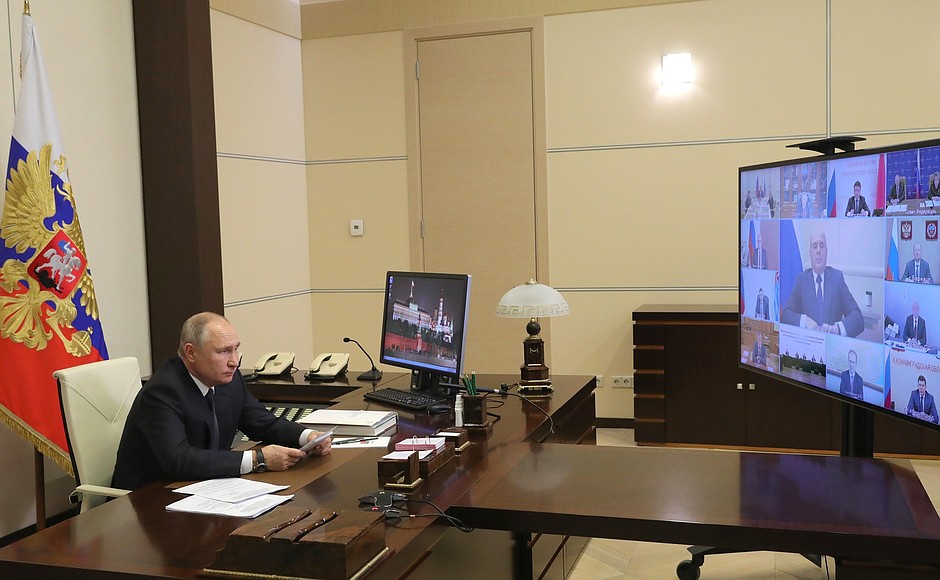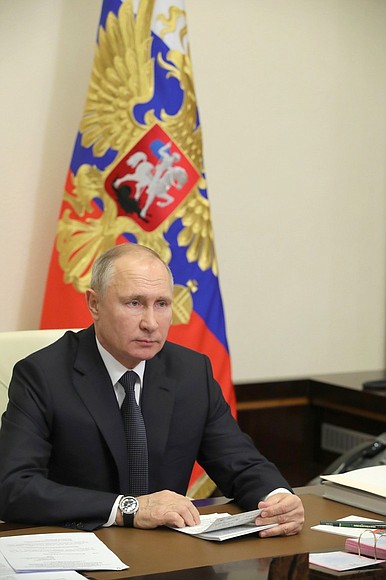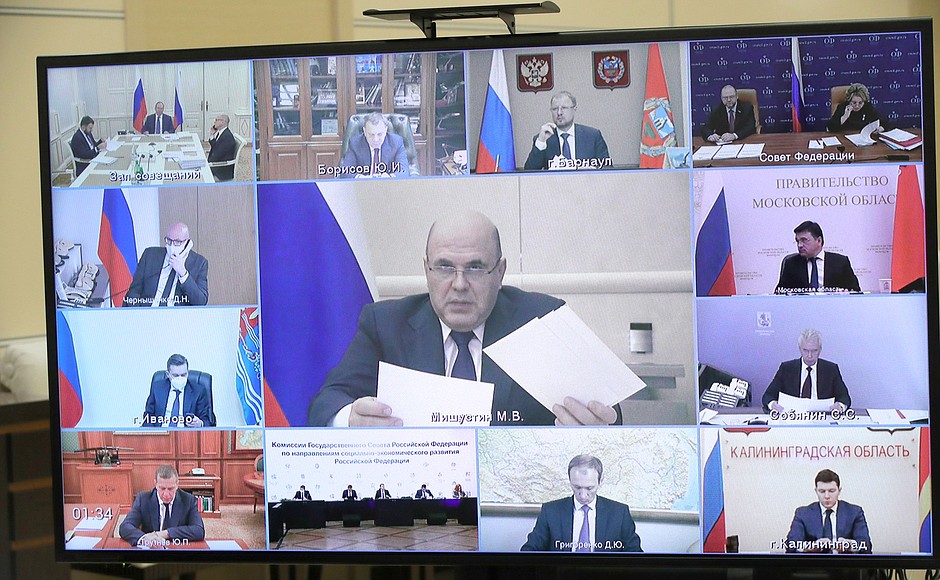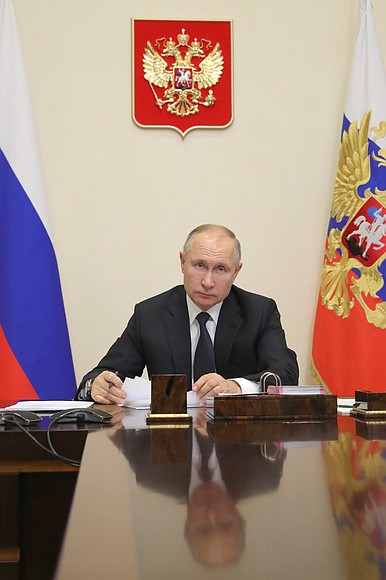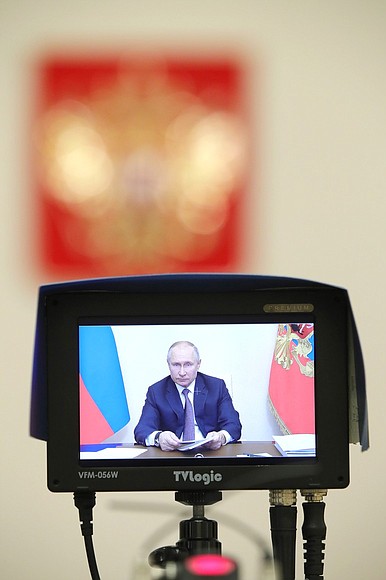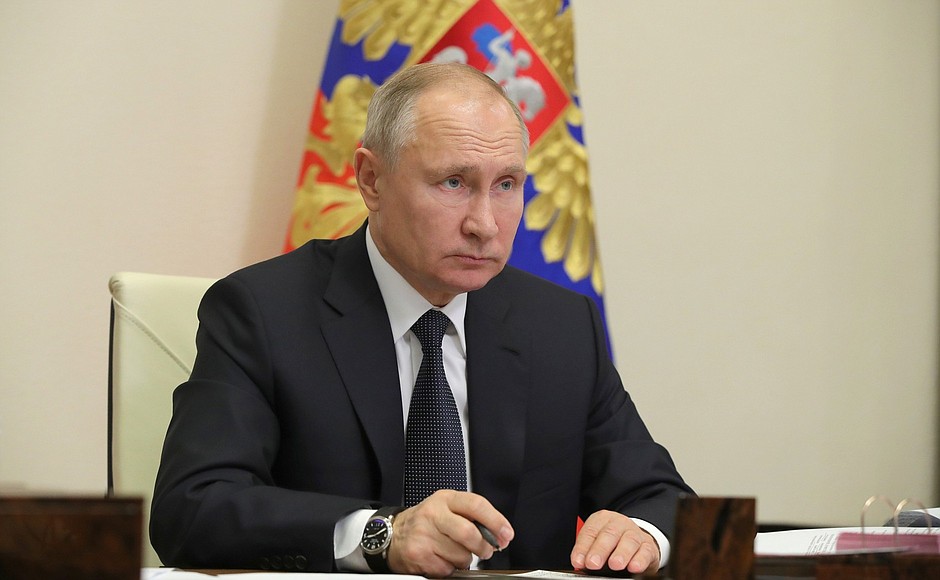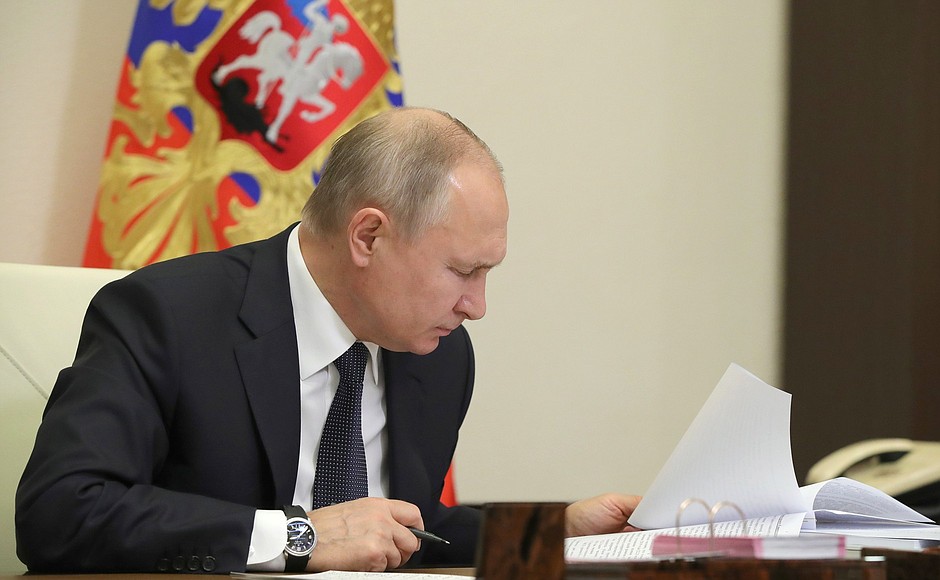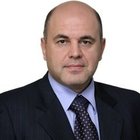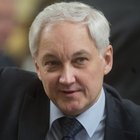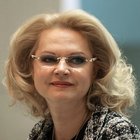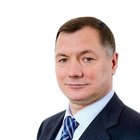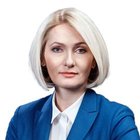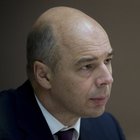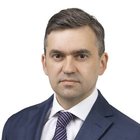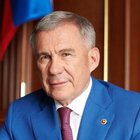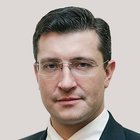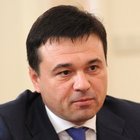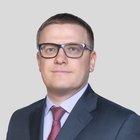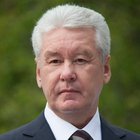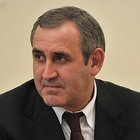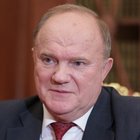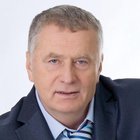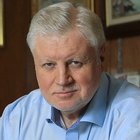The meeting focused on implementing the Executive Order On the National Development Goals of the Russian Federation until 2030.
Speakers at the meeting included Prime Minister Mikhail Mishustin, members of the Presidential Council for Strategic Development and National Projects First Deputy Prime Minister Andrei Belousov, deputy prime ministers Tatyana Golikova, Marat Khusnullin, Viktoria Abramchenko , Dmitry Chernyshenko, and Finance Minister Anton Siluanov, as well as members of the State Council: heads of Russian regions Stanislav Voskresensky (Ivanovo Region), Rustam Minnikhanov (Republic of Tatarstan), Gleb Nikitin (Nizhny Novgorod Region), Andrei Vorobyov (Moscow Region), Alexei Teksler (Chelyabinsk Region), Andrei Chibis (Murmansk Region), Moscow Mayor Sergei Sobyanin, Chairperson of the Yevpatoria City Council in the Republic of Crimea Olesya Kharitonenko; and leaders of State Duma parties Sergei Neverov (United Russia), Gennady Zyuganov (Communist Party), Vladimir Zhirinovsky (LDPR), and Sergei Mironov (A Just Russia).
* * *
President of Russia Vladimir Putin: Good afternoon, colleagues. I am glad to see you all healthy and well. Welcome.
Today we are holding a joint meeting of the State Council and the Council for Strategic Development and National Projects. First of all, we will discuss our goals for the future. This is why we are working together today.
We all understand that this year has been difficult both for Russia and the entire world. The coronavirus epidemic has been a challenge for national economies and for social welfare in almost every country, and a serious ordeal for people.
These issues have been and still are our primary focus. We have been concentrating and mobilising our efforts and resources in this area. We are doing this because it is extremely important today. As I said, it is a major challenge. But it should not undermine our development agenda. We have repeatedly discussed this as well. Qualitative and continuous progress is of absolute strategic, crucial and vital importance for our country. Considering the entire scope of demographic, geopolitical, economic and technological factors, we cannot afford to stop. We have been saying this in different formats but, regardless of the current circumstances, we cannot afford to pause our development even for a minute.
This systematic work requires our joint and coordinated efforts at every level of government, across all Russian regions and, obviously, at the level of regional authorities. The State Council was granted a new constitutional status exactly for this purpose, which is to ensure that Russian constituent entities and municipalities are more involved in making nationwide decisions. The powers and the composition of the State Council were expanded. As you already know, the council now includes representatives of municipalities as well as public associations, businesses and trade unions.
Specialised State Council commissions have been established for drafting our common position and for using the best socio-economic development practices, and I have recently signed the relevant documents. The leaders of Russian regions will head them. As I have said right now, the permanent commissions will work permanently and involve the heads of municipalities. Consequently, the heads of local government agencies will be able to directly raise the most pressing local matters before the State Council.
However, these organisational innovations which are also important are not the only thing that matters. In-depth changes are, of course, important in order to bring a new quality to the work of government agencies at every level, including federal, regional and municipal, as well as to ensure their cost-effective performance. In the long run, this will improve people’s lives and achieve national development goals.
I would like to recall that we specified and updated them this past July, and we have expanded the so-called planning horizon up to 2030. At the same time, we have ensured full continuity of tasks and results of previous years, and we have drawn necessary conclusions. For example, we prioritise such aspects as advanced infrastructure development, environmental well-being and the digital transformation of all spheres of our life.
I would like to once again mention what I discussed during my opening remarks. Objectively speaking, owing to the difficult situation, some plans that we wanted to implement earlier this year were postponed, put on a back burner, so to say. However, no one has abolished the task of attaining major breakthrough, quantitative changes in all key spheres of our life. We need to focus on the agenda to the greatest possible exent, work intensively and move ahead all the time. I am drawing the attention of all colleagues at the federal level, in the regions, in municipalities and at the local level that we must work on all this and be guided by these aspects.
It goes without saying that I am expecting the Government to set ambitious tasks for the years to come, but I would like to make a reservation that it is not so hard to formulate these tasks per se. In particular, all of us, the entire people of the Russian Federation, are expecting large-scale achievements from this work, as well as tangible results and real positive change in our citizens’ lives.
You and I talk about this all the time, and we constantly focus on this. Today, let us discuss this agenda in greater detail and see what has been accomplished and what has not been done. There are a lot of objective reasons. I am aware of this, as I have just said. Quite possibly, there are also subjective reasons, we have to admit it and not shy away from this. An objective and absolutely open analysis will make it easier for us to move forward.
Mr Mishustin, you have the floor, please.
Prime Minister Mikhail Mishustin: Mr President,
First, I would like to report on the situation with payments. We opened an online form for filing applications right after you announced lump-sum payments for families with children under eight. The website received over 1.5 million requests for information in the first three hours. In all, 150,000 applications were filed during the same period. This is an all-time high in terms of applications handled by the Government services website. For comparison’s sake, the website handled 1.5 times fewer applications for the most popular payments covering children aged 3–16 in the first three hours.
Vladimir Putin: Mr Mishustin, this is explainable: People want to get this payment before the New Year holiday, just like you and I had planned, so as to buy food and gifts for children, etc. People want to do this before celebrating the New Year, and this explains why we have received 1.5 million applications in three hours.
Thank you very much, please continue.
Mikhail Mishustin: You are absolutely right.
Naturally, there were no problems, the entire technological process was streamlined and efficient. As of the morning of December 23, parents who did not receive any earlier payments submitted almost 500,000 applications for children born after July 1. In all, 350,000 applications came in to correct their bank account numbers. Families that received presidential payments earlier this year got the money automatically without submitting an application. Almost 67 billion rubles have been paid out to date. Families raising over 13 million children, including over 400,000 children covered by new applications, have received the money.
I would like to note that parents and guardians who have not yet submitted applications can do so until April 1. The federal budget provides for all funding for presidential payments, due to be received by all families with children under eight. I would like to note that this sum is not subject to income tax.
Mr President, colleagues,
The creation of an effective system for supporting families with children is a high-priority aspect of the Government’s work. We are addressing this task while implementing the national development goals, charted in July 2020. Mr President, you have just noted this. Following your instruction, we have drafted an Integrated Plan aiming to achieve the national goals. This huge strategic document has been drafted for the first time, and it will link the July executive order, national projects and state programmes.
Essentially, the plan answers three main questions: when, where and which steps the Government proposes to take in order to achieve these goals. Developing the Integrated Plan required extensive work. The National Projects Centre established 25 inter-agency working groups that include hundreds of people from almost every ministry and agency. They thoroughly reviewed every detail and broke down the national development goals. Digital transformation managers at both the federal and regional levels served as the linchpin of this work.
As a result, all participants supported and approved the plan. Then it went through an extensive discussion involving representatives of the Federal Assembly, the Civic Chamber, the Russian Popular Front, the business and expert communities and a State Council working group.
We are very grateful to everybody for this work. The approaches to achieving the goals were thoroughly examined and documented in the plan. Every process was described not only in terms of its substance but also with an eye to which operative instrument, state programme, national project or roadmap this package of measures will be applied to as a specific action plan with deadlines, assigned coordinators, benchmarks and funding according to budget planning.
The outcome is an elaborate plan that describes the logic of achieving every national goal. The plan will serve as the primary navigator through the measures arranged. At the same time, the plan specifies areas of responsibility and sets specific tasks for all the ministries, agencies, regional administrations and development institutes, and every step and every measure contribute to the common result, which is improving the quality of life and building a comfortable environment for development.
The Integrated Plan breaks down targets by month and by every constituent entity so that people know and understand when and which results they will see not only on a national scale but also in a specific region or territory. Substantial resources will be allocated to fulfil the plan. That is, over 39 trillion rubles within the next three years, or around 13 trillion rubles per year. To put this in perspective, the annual cost of all the national projects is only about 2 trillion rubles. Therefore, budget spending is now strictly bound to the achievement of the national development goals.
What is extremely important is that the major part of these funds will be allocated for two areas, social programmes (maintaining the population, protecting health and wellbeing) and economic development. In essence, it means supporting our citizens by ensuring their employment and income.
A special section intended to support the constituent entities of the Russian Federation was written at the suggestion of the State Council working groups. It provides considerable resources for regional development.
The Government has already adjusted the national projects in accordance with the updated purposes and goals. In each of them the Government has identified socially important results that directly influence the quality of people’s lives and the conditions for conducting business, and has described the indexes for achieving them. Their implementation has not stopped this year either. For example, almost 65,000 families saw improved housing thanks to mortgages with preferential terms, and about 30,000 more children, up to the age of 3, can now be admitted to preschool facilities under the Demography national project. Currently, the state programmes are being adjusted even more finely. Each of their activities is to be tied to the Integrated Plan. And we are set to complete this process as early as March.
The information control system will become a single technological platform for coordinating plan implementation. We will have a new efficient control tool that uses specific numerical values and not subjective estimates where we can follow the developments online; and we will be able to step in at almost every stage to prevent any deviation from the plan. For greater control, we will provide access to this system for the authorities at all levels. This will help increase the effectiveness of our response measures and avoid duplicating decisions at different levels.
In drafting the plan we proceeded from the assumption that it should be a flexible and efficient mechanism, this is why we suggest the ability to adjust the Integrated Plan annually. To date, this operational period runs until 2024, that is, an additional year in the three-year budget. We need to arrange our work so that we can promptly and accurately respond to various challenges and risks, naturally after providing for the required transparency of the plan structure and the Government’s responsibility in attaining the national goals.
Today, my deputies –Deputy Prime Ministers in charge of respective areas – will talk in greater detail about the activities that we have included in the Integrated Plan.
Mister President, colleagues.
I think that the approval of the Integrated Plan and updated national projects at today’s council meeting are the result of our team work, which allows us to start carrying them out as quickly as possible, starting January 1.
Thank you.
<…>
First Deputy Prime Minister Andrei Belousov: Mr President, colleagues,
The key task in the framework of implementing the Decent and Effective Jobs and Successful Enterprise national development goal is to enter, after the recovery period, a trajectory of sustainable economic growth at a rate above the global average, or at least 3 percent per year.
I would like to stress that this task is quite ambitious. In the past eight years, since 2013, we have not been able to achieve this growth rate. The highest growth rate over this period was recorded in 2018 at 2.5 percent while the average growth rate, even without reference to the decline in 2015, was only 1.4 percent, or half the target. This is due to systemic factors – mainly, low investment activity and a low labour productivity dynamic that inhibits the increase in real wages, income and consumption.
Therefore, this task requires the breaking of the boundaries of inertial development, twice. It requires renewal of the economic model within a very short period of three to four years, overcoming its structural flaws and creating new internal sources of growth.
How are we going to achieve this? What is our strategy? Briefly, we want to take advantage of the factors where there are significant resources for acceleration. I am talking primarily about investment, small entrepreneurship, non-commodity exports and labour productivity.
Allow me to cover only the main aspects of these factors. The first factor is expediting investment, with new technological capacities based on Russian equipment and technology. The average annual growth rate for investment in 2022‒2024 must reach at least 5.3 percent, or 70 percent higher than the GDP growth.
Based on the national goal targets, the investment must go up 21 percent by 2024 and at least 70 percent by 2030. How can this be done?
The mechanism of agreements on protection and encouragement of capital investment is already in effect. As of today, 25 agreements have been signed, while the plan was 20 agreements, and the total value of these agreements is 1.12 trillion rubles, including almost 900 billion rubles to be invested by 2024. Thanks to the investment, more than 23,000 new jobs will be created. By 2024, we plan to close at least 1,000 agreements worth 14 trillion rubles.
Next. A system of investment support for medium-sized companies is being developed at the regional level. The components of this system include an investment declaration, an investment map of the region, a set of investment rules for the region, a plan for the development of industrial infrastructure, and a personnel training plan. According to the schedule, this system will be launched in several pilot regions no later than September 30, 2021. In the State Council framework, Sakhalin Region Governor Valery Limarenko is actively involved in this work together with the Government.
Next. The so-called investment package is being put together – proposals from business associations to improve investment conditions. It includes almost 200 specific proposals, of which we plan to launch about 50 as early as next year as part of the effort to improve the business climate.
Finally, it is planned to significantly expand the range of financial instruments to raise funds for investments. This year, we arranged the issue of perpetual bonds. The issue has already raised 313 billion rubles for Russian Railways’ investment programme. Next in line are infrastructure bonds to finance road construction, green bonds to support implementation of the best available technologies, and a number of other financial instruments.
We regularly, on a monthly basis, discuss and adjust all the mechanisms with the Russian Union of Industrialists and Entrepreneurs, the Chamber of Commerce and Industry and the Delovaya Rossiya (Business Russia) association.
The second factor in accelerating growth is the development of the small and medium-sized enterprise sector. In four years, the number of people employed by SMEs should increase to 23 million, and by 2030, to 25 million. Revenue per SME should increase by at least 4 percent annually, in comparable prices.
What else are we planning to do? First of all, there is the expansion of taxation plans. Even this year, along with cancelling UTII [Unified Tax on Imputed Income], conditions have been created for a soft transition to other tax plans – patents and a simplified taxation system. The next step is to create comfortable conditions for the transition from special taxation plans to general taxation when a company expands its scope of activities, revenue and staff numbers.
Next. Increasing the availability of preferential loans at a reduced interest rate of seven percent or less. It is planned to issue 700 billion rubles in such loans a year, covering 11,000–13,000 SMEs annually. In four years, this programme will cover at least 2 million people. It is also planned to expand SMEs’ access to new financial instruments such as factoring.
Enabling SMEs to access the Bank of Russia's express payment system is another priority, offering businesses an opportunity to benefit from transaction fees below 1 percent. As early as in 2021, at least 40,000 SMEs will have been connected to the express payment system, and this figure is expected to reach 400,000 business entities in 2024.
The next priority is to support exports by SMEs. Special solutions are being introduced which include a dedicated trading platform and a marketplace, as well as services for obtaining the required approvals and certificates, accessing logistics infrastructure for delivering goods to buyers, and a payment system. This effort is being carried out in cooperation with the Russian Export Centre, the Russian Post and Russian Railways.
Finally, let me highlight the creation of a dedicated digital system for sole traders and small businesses. They will be able to use it to get the services and assistance they need from government agencies, development institutions and banks through their account within this platform, expected to be launched in 2021.
We are working with the business community on fine-tuning support measures for small and medium-sized businesses, primarily with the OPORA Russia association, as well as the State Council working group chaired by Kaliningrad Region Governor Anton Alikhanov.
The third factor is support for non-commodity exports outside of the energy sector. The Presidential executive order sets forth the goal of increasing non-commodity, non-energy exports by at least 70 percent in physical terms by 2030. Accordingly, this figure is expected to grow 22 percent by 2024, which amounts to an increase of $35 billion. To put this in perspective, annual engineering exports are currently below $30 billion.
There is no way we can deliver on this objective by simply scaling up support measures for our exports. To succeed, we need to bring about a substantial increase in the number of major non-commodity industrial and agricultural exporters by about one third, from 7,000 companies at present, up to some 10,500 operators. This year, this has led to a complete overhaul of the export support architecture in order to place exporters front and centre as the ultimate beneficiaries of these measures. Today, this system operates under the classical acceleration model. A digital one-stop-shop platform, already launched by the Russian Export Centre, will serve as an entry point. Next year, we intend to offer more services and fine-tune the one-stop-shop offerings as part of a customer-centric ecosystem.
Next, we need to work out the logistics for delivering financial and non-financial support to exporters depending on their profile and maturity. The system offers a total of 40 measures of this kind covering all the stages in the lifecycle of exported goods. Next year, we intend to launch a registry of export support beneficiaries in order to be able to track the effectiveness of these measures in real time.
An exporters’ council has been established to gather feedback. It will meet regularly. The first meeting took place on December 9.
The fourth factor of growth is increasing labour productivity. The goal is to build a large-scale, systemically important layer of large non-commodity companies in the Russian economy that would demonstrate a labour productivity growth of over 5 percent per year. While today the number of such companies is around 2,000, or below 10 percent of the total number of large non-commodity companies, by 2024 this number must increase to 6,500 companies, or to 30 percent.
How can we achieve this result? We are building a system, let’s call it a modern Gastev institute, that consists of three interrelated blocks. They are identifying and implementing best labour productivity practices through consultations and training support of companies; a digital platform that offers best digital solutions for optimising corporate, logistic and production processes in companies; and a workforce retraining and efficiency support system as part of the WorldSkills programme.
We are working in cooperation with Rostec corporation. Next year, we are going to also involve Rosatom, Russian Railways and a number of major private companies that are particularly interested in this system.
In conclusion, I would like to say that we have done a thorough assessment of the contribution of these four factors to the economic growth. I can report that the first two factors, accelerating investment and developing the sector of small and medium-sized businesses, both ensure an additional annual GDP growth of about 0.5‒0.6 percentage points each. Increasing non-commodity non-energy exports gives 0.4 percentage points and increasing labour productivity about 0.2‒0.3 percentage points. The major effect will be seen after 2024. In total, the additional GDP growth will be 1.5‒2 percentage points. I would like to stress that this is annual growth, which is necessary and sufficient for achieving the goal set by the President of accelerating growth to 3 percent.
Thank you.
Vladimir Putin: Thank you very much, Mr Belousov.
There are a few things I would like to point out. These aspects might seem minor; however, I discussed this with you and the Prime Minister recently. In fact, we often talk about it.
I do not want to subject your report to an analysis right now although it should be noted that, judging from the documents, the number of workers involved in small and medium-sized businesses is growing rather slowly. Perhaps this is due to the fact that, despite the growing number of SMEs in the economy that operate on modern technology, including the so-called digital maturity in key sectors and in small and medium-sized businesses, the number of workers will not grow as fast as the scope of this sector should be growing in the structure of the economy in general. It is possible. But I would like to point this out. This is the first point.
But there are other things that may seem to be trivial but we talk about them all the time, and in reality they are very important to the people as well as for the country’s development. What am I talking about?
Regional aviation development. We finally have a regional jet of our own (I am not even talking about the fact that we have transferred our competencies from the Czech Republic and started production here); we also have our own Il-114 turboprop aircraft. A merger has been completed of the companies in the Far East to create one decent airline. The new Transport Minister has reported to me about this.
But what else is important? It is important for us to stitch together our entire vast territory with infrastructure. Indeed, the situation in the past decades (in fact, since the 1990s) has been such that people from the Far East have problems getting to the European part and back. Travel is very expensive. There are many options to resolve this, and we talk about this all the time.
There is one solution – it would seem the simplest, but it also needs to be done. The Prime Minister and I recently discussed this, and I asked him to specifically take care of this issue. We have 7 billion in subsidies for transport services with the Far East. Transatlantic and trans-Siberian flights have shrunk now. Those revenues… How much did we have? They made $30 million each, and Aeroflot used that money to subsidise transportation from the Far East. But they fall short of that revenue now that the global aviation is grounded at airfields and there is far less traffic.
Shrinking traffic means lower revenue, while the number of passengers from the Far East wishing to visit their relatives or, in general, to visit the European part more often, for whatever reason, is fortunately not decreasing. So we need to keep this in mind and be sure to do it. But 7 billion that we have for those flights, for subsidies, I think it is not enough. Not just think, but I am sure that this is not enough. You may have grandiose plans for the next decades, until 2030 and for another thousand years ahead, but people need to fly now. We very much need to stitch the territory together.
How big is the subsidy for passenger transportation by rail, in total, is it somewhere around 20 billion?
Andrei Belousov: If we include the part for suburban commute, then yes, around 20.
Vladimir Putin: Yes, around 20 billion. But the subsidies for transportation from the Far East by air are only 7 billion. I know that the budget has been drawn up, and everything has already been calculated, but nevertheless, I need to point this out to you as someone responsible for this sphere on behalf of the Government, the Prime Minister, the Transport Minister, the Finance Minister – we need to pay more attention, not only to specific age categories of passengers living in the Far East, but to everyone who lives there. We need to think about it. I ask you to do this.
And finally, one more point – issuing infrastructure bonds is good practice, the way Russian Railways did it. But the Russian Railways company did not do it all by itself. It was done with the support from the Government. I would like to thank the Finance Ministry for that. The Finance Ministry provided guarantees, and without those guarantees from the state, this programme would not have been implemented. As far as I understand, VEB was also involved, and others. But I know you all think that this practice needs to be expanded. Well, of course, we need to work on each issue, but we have already talked about it, so do not forget about it, please.
<…>
Vladimir Putin: Colleagues,
We have had a substantive exchange of views today. I would like to once again thank the Government members, and the heads of the Russian regions and municipalities for their hard work over the past year.
But we have a no less difficult and eventful period of cooperation ahead. We have to continue to combat the coronavirus epidemic, to achieve a turning point, maintain a high level of mobilisation in the healthcare system, other public services, and of course, we need to draw lessons from all the problems we have faced and solved, to ensure recovery in employment and embark on a sustainable trajectory of economic growth.
However, I would like to emphasise again that we need to do more than just promptly and smoothly implement anti-crisis solutions. I talked about this at the beginning. We should never narrow our approach, lose the development horizon. We need to increasingly focus on system-wide problems.
This also applies to increasing people’s incomes, which we have just talked about, and to creating new jobs, increasing the availability and quality of healthcare and education, creating favourable conditions for investment and entrepreneurship, and developing infrastructure and new housing. Achieving a higher quality in the areas I just listed and in other key areas, should provide the underlying fundamental response to the challenges we face.
We need to do more than overcome the socioeconomic consequences of the epidemic; we need to ensure development and forward movement in all spheres of life. In this regard, I would like to refer to our historical experience, including the 20th century, when our country went through the most dramatic trials.
There were many difficulties at that time, and maybe it was much more difficult than now. But despite that, even at critical moments when the country was faced with the most severe challenges, we never stopped; work did not stop to create new industries, to develop new territories. Even then, in the most difficult periods of our history, plans were made to launch large and daring projects.
The lesson we must learn is that no matter how difficult it is, we must always think about the future, about further growth, for years to come. We must lay the foundation for that future growth, and do it today, and set ourselves tasks that are commensurate with our country’s and our people’s historical calibre – tasks that in relation to each person, to each family would mean a new quality of life, prosperity, and new opportunities for self-realisation. And for this, I repeat, we need high dynamics and efficiency at the federal, regional and municipal levels.
I know that the Government, the Presidential Executive Office and the State Council working groups I mentioned have carried out large and substantive work to prepare materials for our meeting today, while based on approved approaches and principles. I suggest approving them soon, but not in order for them to be left somewhere on a shelf, but for us to work with them as documents that must be implemented.
Next, the Government has prepared the Integrated Plan to achieve the national development goals. We have discussed this today. I propose adopting today’s draft in a basic form because some points require fine-tuning. It is true that a lot of comprehensive work has been done. I would like to thank my colleagues from the Government and, considering today’s conversation, do the following.
First, bring all the indicators of the Integrated Plan in line with the results of 2020 in order to fully consider the significant changes that have taken place both in Russia and all over the world.
Second, it is necessary that our goals and indicators for the upcoming period until 2024 are in line with the level we are starting from. Several national goals need to be more ambitious. Let me note: the fact that we set long-term goals – until 2030 – does not mean that we can postpone this work indefinitely, or, as they say, until better days.
Third, I would like to ask you to outline the specific plans and results that will be achieved in the next three years on every national goal based on the prepared Integrated Plan, so we can review them after 2023. In this context, let me stress: this goes for the joint work of the Government, all agencies, all Russian regions and the local municipal authorities.
Let me repeat: the outlined tasks and results must be very specific and result in significant development for the country, otherwise all this work is worth nothing. They must show progress on achieving every national goal in practice, not just on paper, and reflect changes in the lives of people.
I propose examining specified lines of national development goal indicators without delay, in two months, next February, at the meeting of the Strategic Development Council. We will again discuss the planned results of this for the next three years at that time.
We can invite the heads of the Russian regions to take part in the council meeting and, at the end of 2021, meet once again with the same group to review it. Why am I saying this? To make it clear that we will be constantly controlling these issues and checking on what has been done and what hasn’t and why.
In conclusion I would like to convey New Year’s greetings to you and your families and colleagues. I wish you success, good health and all the best.
Thank you once again for your work and attention.
All the best.
